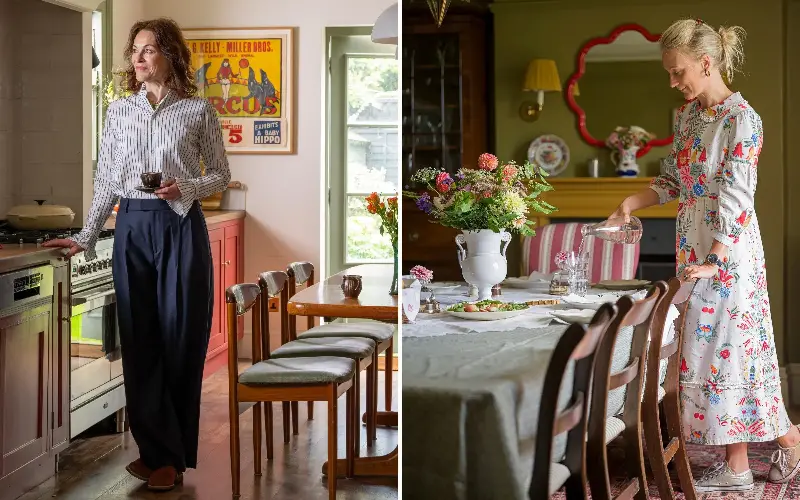
The spacious kitchen-diner has long been the holy grail of home design, and very much at the top of most homeowners’ wish list. But now, a surprising contender is threatening its crown: the good old-fashioned dining room. Long dismissed as stuffy, impractical and quite literally a waste of space, the separate dining room is back in vogue.
In the past three months alone, searches for “dining room inspiration” on Pinterest have jumped 105 per cent, while a recent study from home design platform Houzz saw a 4 per cent increase year on year in homeowners renovating or extending their dining rooms, and an 80 per cent spike in searches for “dining room” – suggesting more homeowners are planning to create one.
So what is driving this revival? While open-plan living has undeniable appeal, it can also come with challenges such as noise, clutter and a lack of privacy. Experts believe that after years of blurred boundaries, people are rediscovering the attraction of separation and rooms with clearer functions.
We spoke to two interior designers – Mary Graham, who has a separate dining room, and Anna Haines, who has an eat-in kitchen – who share their thoughts on the kitchen-dining room divide, and offer their tips on how to design a successful dining space.
In praise of the dining room
Mary Graham, co-founder of London-based interior studio Salvesen Graham, lives in Yorkshire with her husband and their two children, aged eight and 10.
While eat-in kitchens have been popular for many years, Mary Graham has never wavered in her preference for a dining room.
“I have never been keen on that ‘one room does everything’ idea,” she says. “Even when I lived in London in small flats and was unable to have a dining room, I’d still want to lay the table and create a sense of atmosphere. It’s very hard to achieve that if you are eating in a kitchen diner.”
So when she and her family moved to a Yorkshire farmhouse in 2019, one of her non-negotiables was a separate dining room. “I grew up with one and I love the traditions that it fostered in me,” says Graham. Now, with her own children, she continues those rituals. Sunday lunches, celebrations and even weekday meals find their way into the dining room. “It’s about creating distinction from the everyday,” she explains. “It’s a room that allows you to rise to the occasion and show your guests or family that you’ve made an effort.”
For Graham, its appeal has always been the separation from the havoc that can ensue in a kitchen diner. “I make a lot of mess when I cook. I don’t want to sit and eat surrounded by the debris of food preparation,” she says. “Having a dining room allows you to shut the kitchen door on the chaos and walk into calm.” And there are more advantages from a hosting perspective, she adds: “Being able to lay the table days in advance or decorate for a birthday is invaluable. It makes entertaining more relaxed, not less.”
Her own glossy olive-green dining room is layered with a patterned rug, upholstered armchairs at either end of the table, and a mix of lighting. “The lovely thing with a dining room is that you can be a lot more celebratory in the way you decorate it,” she says. “With clients, we’ll often suggest a fabulous wallpaper or a richer palette.”
One of the biggest criticisms of dining rooms is that they often sit empty. However, Graham disagrees: “It’s not a wasted space if you design it cleverly. Our dining room doubles up as a study, a library and a homework room. It’s where I wrap presents, where we do puzzles and where my husband and I can take Zoom calls. If your dining room is used for different functions, it doesn’t feel like an extravagance.”
Graham acknowledges that not every home has the square footage for a dedicated dining room. In a typical Victorian terrace, she suggests turning the often underused “middle room” into a small library-dining space. “It stops it from becoming a dumping ground and creates somewhere intimate for four or six people to dine,” she says.
For Graham, the dining room isn’t about rejecting the kitchen diner outright. “Of course we eat in the kitchen too. But the joy of the dining room is about creating atmosphere, memory and a sense of celebration.”
Mary Graham’s top five tips for creating a great dining room
Decorate your dining room according to how you plan to use it
“If you are more likely to use it during the day for family lunches, the decor can be lighter and more casual,” says Graham. “A dark colour on the wall with lots of candles and silverware lends itself to a more conventional dining experience.”
Have different layers of lighting
It’s important not to stick to a single light source, advises Graham. “Ensure there are lots of opportunities for wall lights, picture lights and candle lights. It helps create mood and atmosphere.”
Always add soft upholstery
Consider furniture that will encourage guests to linger. “Use upholstered rather than ‘hard’ furniture,” says Graham. “It makes a more inviting and comfortable space and is an opportunity to add pattern and colour.”
Ensure the dining room is a flexible space
“Think about what else you can do there to make it work hard and make sure it is equipped for it,” says Graham. “So for instance, if it is a place where the children do homework or music practice, make sure there is storage for all their stuff.”
Be bold in your decor
The dining room is a room where you can indulge your design fantasies: “Because you’re not going to be in there all day, every day, you can experiment more.”
For more information, visit the Salvesen Graham website
In defence of the kitchen diner
Interior designer Anna Haines lives in west London with her husband Viv, their teenage daughters Phoebe and Amalie, and Enzo the dog.
For interior designer Anna Haines, the beating heart of her home isn’t a separate dining room tucked away behind closed doors, but a convivial kitchen diner that brings family, friends and daily life together in one space.
“Having everything in one place feels more manageable and also much less formal,” she explains. “Like many people these days, we don’t do a huge amount of smart entertaining, so a kitchen diner suits us perfectly. It has always been the centre of our family life.”
Interestingly, Haines’s preference for an eat-in kitchen is not because of limited space. “When we moved into this house in 2011, there definitely was the option to have a dining room as there was previously one adjoining the living room,” she says. “But instinctively I knew it wasn’t right for the way we live. I don’t like the flow when spaces are separated like that.”
A key attraction of a kitchen-diner is that the dining table usually lends itself to much more than a place to eat, explains Haines. “It is of course where we gather for family suppers, but we’ve also had marathon board games, and Phoebe, my youngest, does all of her art projects there,” she says. “It’s the one place everyone just naturally gravitates to.” By contrast, Haines believes a separate dining room would be too formal and underused: “Eating in one would feel a bit like a performance, whereas the kitchen diner is just life unfolding. A dining room would end up being used once a month and would be wasted space.”
But what about those moments when an occasion needs to feel special? Haines insists a kitchen diner can feel just as inviting as a decorated dining room. “I like to bring in bold colour through cabinetry.” Her own kitchen units, painted a warming red, are a case in point: “The colours that I’ve got in the kitchen are really joyful.”
To ensure the room feels welcoming and uncluttered when entertaining, Haines says, “One key element is making sure the surfaces are clean and clear and there are no noises from appliances so that it feels relaxing for guests.” Lighting is also crucial: “We have wall lights and surface-mounted spotlights which cast a very low-level light. For smart dinners we’ll just have the two pendants over the dining table and some candlelight. A kitchen diner can have just as much atmosphere as a dining room.”
The majority of Haines’s clients are still keen on open-plan kitchen diners, particularly in London where space is at a premium, and ultimately Haines believes the enduring appeal of an open-plan room lies in its informality. “It pulls everyone in. My daughters may spend time in their bedrooms but they have to come down to eat so it naturally brings everyone together during the day. A dining room just doesn’t do that in the same way.”
Anna Haines’s top five tips for creating a great kitchen diner
Be confident in your use of colour
“I would use colour over textiles in a kitchen diner as it is easier to maintain,” says Haines. “A bold colour can have a huge impact on cabinetry and makes the room feel more inviting.”
Storage is key
A successful kitchen diner needs plenty of storage to avoid a cluttered look. “Consider dividers within kitchen drawers and cupboards to get good value out of each space and to help you find things easily,” says Haines.
Be imaginative with tiles
Bring in colour and pattern by using eye-catching tiles for splashbacks, says Haines. “Reclaimed tiles are always a great idea. You can create something that looks really unique and individual.”
Consider a large table instead of a kitchen island
While a kitchen island can be convivial, a large table is more relaxing. “It allows the space to be more multi-purpose and less clinical,” says Haines.
Install lighting on different gangs
In order to create different moods, it is important to have a mix of lighting that can be controlled separately, says Haines. “You need to have task lighting for cooking but also softer lights for entertaining.”
For more information, visit the Anna Haines website
